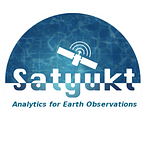How Satellites Are Making Agriculture More Efficient
Satellite data comprises signals sent by crops, soil, water and more, at different wavelengths of light. Processing satellite images can let us know if crops, soil, and water are facing any problems because of the change in climate and weather. With satellite captured data, one can estimate variables like soil moisture, vegetation indices, evapotranspiration, crop health, yield, crop water usage, and so on. With these variables at their fingertips, farmers can put favorable management techniques in place to minimize the inputs, maximize the outputs, and eliminate waste.
Crop Health Monitoring
Satellite estimated vegetation indices (e.g. NDVI, EVI…, etc) look at various wavelengths of light, both visible and nonvisible, to make calculations and data provide information about health and growth of crops. This data enables agronomists and farmers to see stressed crops in a field up to two weeks before the human eye could detect.
The following are benefits of vegetation indices data:
- Data help to find problems, save time, improve field scouting and go straight to the source of the problem without disturbing healthy crops to ground-truthing.
- Growers can identify non-performing areas or arid conditions sooner or detect crop variability within their farms and make quick decisions according to needs.
- Once issues are found and ground-truthing is done, growers can take necessary decisions where needed and save money and resources and improve crop yield.
Optimize Irrigation
Crops need the right amount of water to flourish, and anything extra is a waste and potentially harmful to the crops and soil. With satellite-estimated soil moisture and evapotranspiration data, farmers can take a site-specific decision regarding watering schedules to make sure all crops are getting the right amount of water.
“Farmers can’t take the risk of leaving too much water in the farm because of climatic changes one does not know how quickly it will dry out. ”
The importance of soil moisture data are as follows:
- Soil water serves as a solvent and carrier of food nutrients for plant growth.
- The yield of a crop is more often determined by the water available rather than a deficiency of other food nutrients.
- Optimize water usage.
- Identify correctly water-stressed plants.
- Reduces water resources like groundwater degradation.
- Monitor agricultural drought in near real-time.
- It reduces water-logging.
- It helps in irrigation scheduling.
- Provide insights to growers how much irrigation they need to apply and at what time they need to apply it.
Yield Monitoring and Forecasting
Farmers can make better decisions on when to harvest to ensure good grain quality for high market value. Harvesting too early will cause a higher percentage of unfilled or immature grains, which will lower the yield and cause higher grain breakage during harvesting. Harvesting too late will lead to excessive losses.
Forecasted data can provide insights for growers to plan next season cultivation and many other things based on the yield and forecasting information processed from satellite imageries.
At Satyukt, we have developed proprietary algorithms to get the continuous flow of information throughout the year. Algorithms combine multiple satellite data with greater precision to estimate agro-hydrological variables at a fine scale. We have tested and validated the output of these tools across the globe.
The services offered by Satyukt are as follows:
- Soil Moisture Estimation
- Vegetation Indices (e.g. NDVI)
- Evapotranspiration
- Crop Yield Estimation
- Acreage Estimation
- Health Monitoring
- Risk Estimation
- Rainfall Analysis
- Agriculture Drought Monitoring
